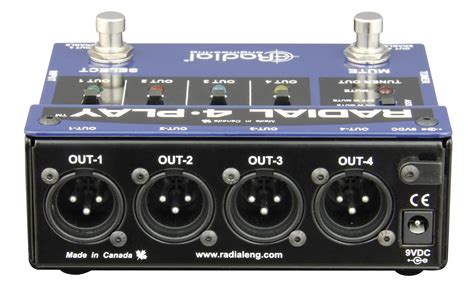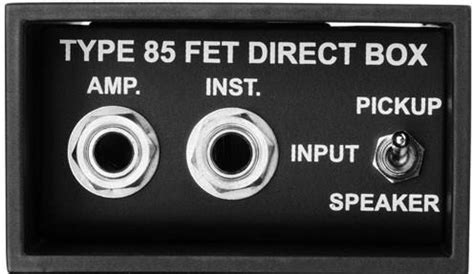do i need a di box for electric guitar If you gig a lot or do a lot of studio recording, you should have a good DI box. It’s a good idea for electric guitarists; it’s an even better idea for bass guitarists and acoustic guitarists. The item is an early model .30 caliber ammo box made of oak with no angled corners or indents. The fittings are painted brass. The stenciled logo , AFIK, is for the 135th Machine Gun Battalion Company C.
0 · guitar amp with di output
1 · di box with volume control
2 · di box explained
3 · best guitar direct box
4 · best guitar di for recording
5 · best di box for recording
6 · best di box for guitar
7 · active di box for guitar
Bed bugs are more likely to live in cabinets that you don’t use very often as opening the cupboard will disturb them and make them scatter around. Simply put, if a cabinet is very rarely used, bed bugs will have more time to live there.
If you gig a lot or do a lot of studio recording, you should have a good DI box. It’s a good idea for electric guitarists; it’s an even better idea for bass guitarists and acoustic guitarists.For electric guitars, you should always use an active DI box. The golden rule of DI boxes is that if you have a passive source, you should use an active DI box. On the other hand, active sources benefit from passive DI boxes.
Active DI Boxes deliver a stronger output signal, making them best suited for low-output instruments, like passive electric guitars. They also tend to provide better impedance matching, allowing you use a wider variety of instruments.
chelsea wolfe house of metal tab
For acoustic-electric guitars, the main advantage of using a DI is being able to run an XLR cable between a DI box and a mixing board. The guitar has a 1/4″ input jack that takes . DI stands for direct injection. That is exactly what a DI box allows. You may hear them referred to as direct boxes too. With a direct box, you don’t need to haul an amp around since it’s designed to convert the signal into a . If you’re using an instrument with a built-in battery-powered preamp, such as an acoustic-electric guitar or bass, a passive DI will do the trick. Also, modern electronic .9.00
guitar amp with di output

.99As such, you can use a DI box to convert the high impedance, instrument level signal produced by your electric guitar to a low impedance, mic level signal. So now, the signal from your electric guitar can be connected to your mic input.
DIs are frequently used to connect an electric guitar, electronic piano, or electric bass to a mixing console’s microphone input. The DI performs level matching, balancing, and either active buffering or passive impedance .
If you're recording guitar at home and want to capture the direct sound of your guitar without an amp, you don't need a DI box. Connect your guitar to the Hi-Z input on your audio interface using an unbalanced 1/4" instrument .Ready to plug into a live system? Record direct into a board? Sweetwater's experts walk you through the many use cases of DI boxes.
If you gig a lot or do a lot of studio recording, you should have a good DI box. It’s a good idea for electric guitarists; it’s an even better idea for bass guitarists and acoustic guitarists.
For electric guitars, you should always use an active DI box. The golden rule of DI boxes is that if you have a passive source, you should use an active DI box. On the other hand, active sources benefit from passive DI boxes. Active DI Boxes deliver a stronger output signal, making them best suited for low-output instruments, like passive electric guitars. They also tend to provide better impedance matching, allowing you use a wider variety of instruments. For acoustic-electric guitars, the main advantage of using a DI is being able to run an XLR cable between a DI box and a mixing board. The guitar has a 1/4″ input jack that takes an instrument cable that can then run directly into the DI, which provides an .
DI stands for direct injection. That is exactly what a DI box allows. You may hear them referred to as direct boxes too. With a direct box, you don’t need to haul an amp around since it’s designed to convert the signal into a balanced signal that goes through an XLR (microphone) output. If you’re using an instrument with a built-in battery-powered preamp, such as an acoustic-electric guitar or bass, a passive DI will do the trick. Also, modern electronic keyboards and CD players are quite capable of producing output levels sufficient to overdrive an active DI.
cheap stamped sheet metal parts
As such, you can use a DI box to convert the high impedance, instrument level signal produced by your electric guitar to a low impedance, mic level signal. So now, the signal from your electric guitar can be connected to your mic input. DIs are frequently used to connect an electric guitar, electronic piano, or electric bass to a mixing console’s microphone input. The DI performs level matching, balancing, and either active buffering or passive impedance bridging to minimize noise, distortion, and ground loops. If you're recording guitar at home and want to capture the direct sound of your guitar without an amp, you don't need a DI box. Connect your guitar to the Hi-Z input on your audio interface using an unbalanced 1/4" instrument cable and you're ready to record.Ready to plug into a live system? Record direct into a board? Sweetwater's experts walk you through the many use cases of DI boxes.

If you gig a lot or do a lot of studio recording, you should have a good DI box. It’s a good idea for electric guitarists; it’s an even better idea for bass guitarists and acoustic guitarists.For electric guitars, you should always use an active DI box. The golden rule of DI boxes is that if you have a passive source, you should use an active DI box. On the other hand, active sources benefit from passive DI boxes.
di box with volume control
di box explained
Active DI Boxes deliver a stronger output signal, making them best suited for low-output instruments, like passive electric guitars. They also tend to provide better impedance matching, allowing you use a wider variety of instruments. For acoustic-electric guitars, the main advantage of using a DI is being able to run an XLR cable between a DI box and a mixing board. The guitar has a 1/4″ input jack that takes an instrument cable that can then run directly into the DI, which provides an . DI stands for direct injection. That is exactly what a DI box allows. You may hear them referred to as direct boxes too. With a direct box, you don’t need to haul an amp around since it’s designed to convert the signal into a balanced signal that goes through an XLR (microphone) output. If you’re using an instrument with a built-in battery-powered preamp, such as an acoustic-electric guitar or bass, a passive DI will do the trick. Also, modern electronic keyboards and CD players are quite capable of producing output levels sufficient to overdrive an active DI.

cheapest sheet metal fabrication
As such, you can use a DI box to convert the high impedance, instrument level signal produced by your electric guitar to a low impedance, mic level signal. So now, the signal from your electric guitar can be connected to your mic input. DIs are frequently used to connect an electric guitar, electronic piano, or electric bass to a mixing console’s microphone input. The DI performs level matching, balancing, and either active buffering or passive impedance bridging to minimize noise, distortion, and ground loops.
best guitar direct box
$49.98
do i need a di box for electric guitar|best guitar di for recording